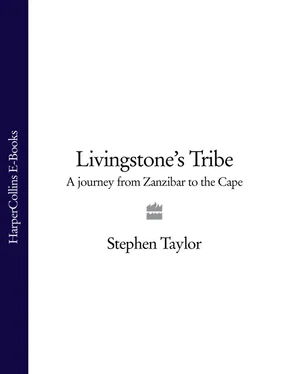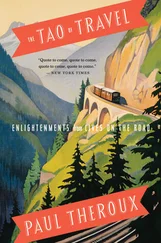BLACK IVORY WAS intrinsic to Zanzibar’s rise. For centuries the rival Arab and Portuguese slaving empires maintained their strongholds along the coast, at Kilwa and Mombasa. Then in 1832, left supreme by the eclipse of the Portuguese, Seyyid Said, the Sultan of Oman, moved his seat from Muscat to Zanzibar. He had no territorial ambitions on the interior; his aim was simply to make the island the hub of a commercial network based on slavery. Within a few years, 40,000 slaves were being sold at Zanzibar’s market annually.
Said was a man of high intelligence, but prosperity evidently stimulated no yearning in him or his successors to emulate the achievements of Arab and Persian culture. The town that grew up at the ocean’s edge was functional rather than imaginative, with mosques as sturdy and unadorned as Said’s fortress down by the harbour. Zanzibar’s sole concession to the aesthetic traditions of Isfahan and Damascus were the ornately carved wooden doors of the merchants’ houses.
Then, in December 1856, two British officers arrived on a sloop borne down from Bombay by the south-west monsoon. Richard Burton and John Speke were the first of a new wave of visitors to Zanzibar. From the quest for the Nile’s source flowed everything else – the mission to Uganda, the opening up of East Africa and in due course the settlement of Kenya. Speke and Burton’s expedition to the Great Lakes and, that same year, Livingstone’s clarion call to the students of Oxford and Cambridge which summoned a generation to service in Africa – these were the first steps in the ‘Scramble’ for Africa itself.
Burton was in the full flush of his early brilliance and, in the six months he and Speke spent preparing for their journey, acquired enough information for a two-volume study of Zanzibar. His fascination with Islamic culture, and with matters outlandish or lubricious, had been kindled on army service in Sind and travels in Egypt, Arabia and Somaliland. Yet even he found Zanzibar strong meat. The port was ‘a filthy labyrinth, a capricious arabesque of disorderly lanes, and alleys, and impasses, here broad, there narrow; now heaped with offal, then choked with ruins’. Of local sexual practices he was even more disapproving: gonorrhea was ‘so common it is hardly considered a disease’; the Arabs were ‘weak, effeminate and degenerate’ due to ‘excessive polygamy and unbridled licentiousness’.
Burton had been fired some years before by the talk of a German missionary, Johann Krapf, at Shepherd’s Hotel in Cairo. Little more was known of the African interior at this time than had been advanced by Ptolemy 1,700 years earlier in a map showing the Nile taking its rise in two great lakes watered by the Lunae Montes , the Mountains of the Moon. From Krapf, the Englishman heard about a snow-capped mountain far inland, virtually on the Equator. Now, doing his rounds among the Zanzibari traders, he was given similar accounts and also of a great lake lying at the end of the main caravan route to the interior.
Many others were to be drawn to Zanzibar, which became the starting-point for all subsequent exploration. Livingstone made his first visit in 1866 when entering the lists to find the Nile; the newspaperman, Henry Stanley, followed five years later to find Livingstone, and again in 1887 to find Emin Pasha; the missionary, Alexander Mackay, passed through in 1877 on his way to find souls to save in Uganda, and was even more mortified than Burton: ‘Zanzibar is an island no greater than a county of Scotland but as great in crime as the Babylon of the Apocalypse’, he declared fervently; above all, perhaps, there was Sir John Kirk, the British Resident in Zanzibar.
Kirk was one of Livingstone’s acolytes, a member of his Zambezi expedition who had been shattered by what he had seen of slavery. From the whitewashed and shuttered British consulate beside the Sultan’s palace, Kirk worked to advance Livingstone’s mission to eradicate the trade and replace it with the three Cs of Christianity, commerce and civilisation. It was Kirk who issued the Sultan with an ultimatum to close the slave market. And when Susi and Chuma brought Livingstone’s body back from Chitambo, Kirk was there to receive it, and carry it back to triumphant burial in Westminster Abbey.
So many spirits to be found, then, in Burton’s arabesque of disorderly lanes. But how remote they now seemed. Zanzibar’s old buildings suffered a fate common in rundown but historic places discovered by tourism: structures not terminally dilapidated were being hastily done up and turned into hotels. Kirk’s consulate had become the headquarters of a state corporation. The Beit el-Ajab, or House of Wonders, the first palace of the sultans, was occupied by the ruling party.
The ghosts of a later era lingered in another crumbling pile. Africa House Hotel used to be the English Club, a Zanzibari mansion in traditional style. A pair of cannons at the door led to a broad staircase from which a moth-eaten buffalo head glowered down and which led to a balcony overlooking the sea. Forty years earlier, men in khaki and white duck loitered here over clinking glasses as the sun set. The sight was just as spectacular now and by late afternoon the balcony was congested with tourists. As the pyrotechnics of a sunburst unfolded and the Indian Ocean turned from gold to black, the crowd fell silent. It was as Wolfgang Dourado said: the British always had a good eye for the best sites.
‘I COULD TAKE you on the motorcycle,’ Canon David said brightly.
It was not an option I had considered. Canon David, as his congregants called him, was the vicar of Zanzibar, a missionary priest from Wiltshire in his mid-seventies who had some difficulty ascending to the pulpit. The question of how I might get to the village of the freed slaves had not entailed being his passenger on two wheels.
The machine was Chinese-made and as noisy as a new year firework show in Shanghai. Canon David manoeuvred it into position like a maribou stork caught astride a fence. Climbing on to the pillion, I realised that neither of us had a helmet. The first test was infiltrating the traffic on Creek Road. Matatu taxis, scooters and buses flew in either direction. We lurched out, Canon David sounding his hooter in admonition. Astonishingly, as if realising that he was not to be trifled with, the traffic parted. As we proceeded, he waved airily about him while steering with one hand and providing a running commentary over his shoulder. ‘Old cricket ground,’ he shouted, pointing towards an overgrown maidan set about with orange-blooming spithoedea trees. ‘State house – used to be the governor’s residence.’ Groves of mango trees and coconut palms flashed past until our hectic pace slowed at the village of Mbweni. Canon David dropped me and wobbled jauntily off on his rounds. I walked down a path to St John’s.
At first it seemed too English a scene for pathos: a small country church, more appropriate to a parish in the shires. But the red roof was corrugated iron, the square bell tower had been weathered to grey-black and the wooden door was carved in the florid Zanzibari style. The churchyard was a sunbaked square of dirt surrounded by a jungle of palm trees. Here Caroline Thackeray and her ladies were buried.
The venture had begun with all the absolute certainty and high-mindedness of the Victorian church. In 1871, the Universities’ Mission to Central Africa, the body formed in response to Livingstone’s appeal, bought thirty acres of land from the Sultan, five miles or so from the town. It was a tranquil spot, set against the background of a milky opal sea. There was an air of the retreat about the place and both the Sultan and Kirk maintained country residences here. The first freed slaves were brought to Mbweni in February 1874. Bishop Edward Steere wrote thankfully: ‘We begin our village with seven men and fifteen women.’
Читать дальше












